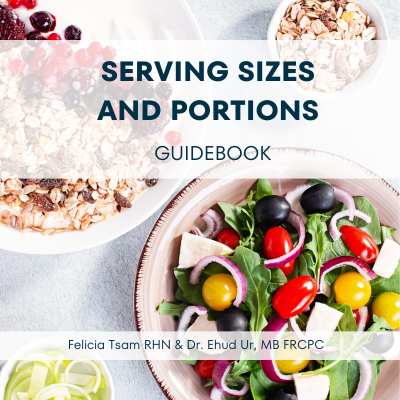Interview with Dr. Ur
Serving Sizes and Portions Guidebook
Hello beautiful people! Today is a good day. We just launched our day to use guide to serving sizes and portions and are excited to make it accessible to all.
Navigate nutrition labels like a pro! Our guidebook is here to simplify the overwhelming world of serving sizes and portions for you. You’ll discover:
What food labels, serving sizes, and portion sizes are
The current guidelines
How to find the information you’re looking for on a food label and how to use it
How to practically implement the information by showing you how how to build a better meal and estimate calories based on standard serving sizes.
Want to hear something mind blowing? The “serving sizes” on packages are just made up. They’re not recommendations. The manufacturer gets to decide what the serving size is based on what is ‘customarily consumed’. My question is, by who?! Are we talking about my 6 year old niece or my 45 year old male neighbour? Don’t get me wrong, we need food labelling. It is a fantastic way to monitor our intake of calories, fat and sugar and to make sure we’re getting enough fibre and protein. But they’re more useful when we understand what we’re looking for. Where we aim to clear up the confusion is between serving sizes and portion sizes. You should be able to walk into a grocery store and look confidently at a food label.
Of course, we have goods that don’t have labels like bakery goods, fish, meat, fruits, vegetables, bulk beans and grains etc. and that is another reason why you can’t rely on nutrition labels alone.
It is the culmination of knowledge of food labels, portion sizes and personal needs that is going to lead you to sustainable weight management and long-term health.
I did a short interview with Dr. Ur who’s guidance was crucial when writing this book on serving sizes and portions.
Dr. Ur, MB FRCPC
Dr. Ur is an Endocrinologist and Metabolic Specialist with more than 45 years’ experience as a doctor. He is located in Vancouver, BC and specializes in neuroendocrine disorders, diabetes and obesity.
Dr. Ur's has published over 150 papers, chapters, and abstracts, with his influential work garnering over 7000 citations.
Felicia: Dr. Ur, why did you decide to co-author this guidebook with me?
Dr. Ur: Serving sizes and portion sizes get brought up in my clinic all the time. There is a lot of confusion and I felt a guidebook on serving sizes and portions was important. There are plenty of resources for people to access but the way we have laid it out is practical. People need practical resources for weight management more than ever these days.
Felicia: Dr. Ur, why do you think there is so much confusion around serving sizes and portion sizes?
Dr. Ur: Probably because “serving sizes” were pushed generically for so long. There is no one-size-fits-all diet or portion size for a population that differs so greatly in ethnicity, height, weight and access. Try telling someone in northern Canada to get 5 servings of fruit a day during the winter months - it’s not likely to happen every day.
Felicia: How do you think understanding serving sizes is useful in weight management and to maintain good health?
Dr. Ur: It’s all about informed choices. If you understand the basics of serving sizes, you can better estimate the calories in your meals and when cooking. You can decide which foods to eat and feel confident. For example, if you’re feeling snacky and you know 1 bowl of chips is about 1 cup of chips is about 150 calories but 1 cup of air popped popcorn is 31 calories, then you can decide based on your goals which you’re going to have.
Felicia: What do you think about the most recent Canada Food Guide recommendations?
Dr. Ur: They’re fantastic! It was the first time in decades there was no industry influence which was reflected in the recommendations. The focus on plant proteins and water being the drink of choice was a huge change from what we saw before.
Felicia: How do you think people can use serving sizes to manage their weight?
Dr. Ur: The first step to weight management is understanding how many calories you need to be eating for whatever your goal is – weight loss, gain or maintenance. Once you know what that number is, approximately, then you can begin to use and understand standard serving sizes and how to use nutrition labels.
Serving sizes also act as a guide to help individuals become more aware of the amount of food they are consuming. By understanding recommended servings and calories, people can avoid overeating and maintain a balance between calorie intake and expenditure.
Of course, those who aren’t interesting in losing weight or are unconcerned with calories don’t need to know how many calories are recommended per se but even healthy individuals should follow some guidelines for foods that are unhealthy and for foods that should be limited.
I want to thank Dr. Ur for taking the time to answer these questions so thoughtfully.
If you want to dabble a bit in the word of nutrition labels, you can check out many of the nutrition trackers online (MyFitnessPal, Cronometer etc.). We highly recommend you play around, entering the foods you eat in the estimated amounts and read over the information in the nutrition label.
We know it’s confusing and overwhelming, which is why we created this concise guide for you - Practical resources for practical needs!
Share the wisdom! Spread the word about our Serving Sizes and Portions Guidebook with your friends and family. Knowledge is power, and together, we can make healthier choices.


